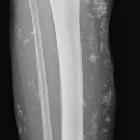thymic carcinoma








Thymic carcinoma is part of the malignant end of thymic epithelial tumors.
Epidemiology
Patients are typically 50 to 70 years of age at presentation .
Pathology
The incidence of paraneoplastic syndromes is thought to be low. At least 10 different histologic variants have been described . The most common subtypes are squamous cell carcinoma and lymphoepithelial-like carcinoma .
Classification
Labeled as "type C" under the WHO classification scheme for thymic epithelial tumors.
Radiographic features
CT
Useful features for differential from more benign thymic epithelial tumors include :
- larger and highly aggressive anterior mediastinal mass
- areas of necrosis, hemorrhage, calcification, or cyst formation
- gross invasion of contiguous mediastinal structures and wide spread to involve distant intrathoracic sites
- high incidence of extrathoracic metastases
Nuclear medicine
FDG PET-CT may be useful in differentiating thymic carcinoma from other thymic neoplasms, thymic hyperplasia, and normal physiologic uptake. The standardized uptake value (SUV) for thymic carcinoma is considered to be significantly greater than that for invasive or noninvasive thymoma, often with an SUV cutoff point of 5.0, thymic carcinoma can be differentiated from thymoma with reasonably high sensitivity (84.6%), specificity (92.3%), and accuracy (88.5%) .
Treatment and prognosis
They are often associated with a poor prognosis.
Differential diagnosis
For an invasive anterior mediastinal mass lesion consider:
- aggressive mediastinal germ cell tumor
- primary mediastinal lymphoma with invasive spread: lack infiltration
- lung cancer with mediastinal invasion
Siehe auch:
- Thymom
- Tumoren des vorderen oberen Mediastinums
- systemischer Lupus Erythematodes
- Thymushyperplasie
- mediastinale Keimzelltumoren
- Tumoren des Thymus
- WHO Klassifikation der Thymome
- Masaoka staging system
- Staging Thymome nach Masaoka
- WHO classification scheme for thymic epithelial tumours
- mucoepidermoid carcinoma of thymus
und weiter:

 Assoziationen und Differentialdiagnosen zu Thymuskarzinom:
Assoziationen und Differentialdiagnosen zu Thymuskarzinom:






